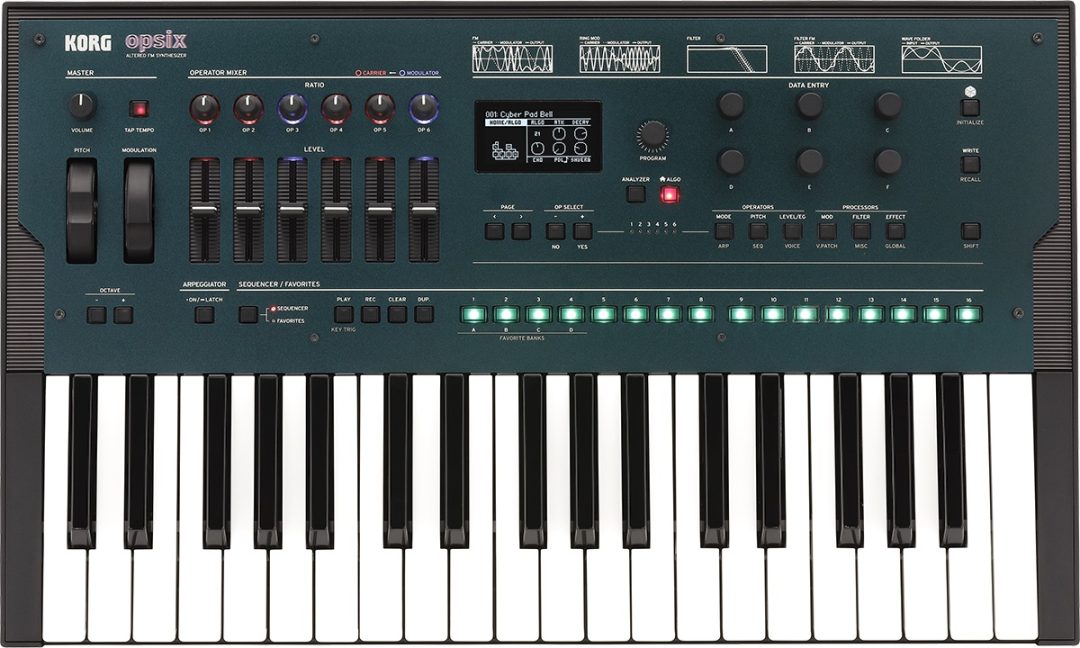Korg graced the synthesizer space with two new releases in 2020. One, the Wavestate, made its full debut at Winter NAMM that year, while the Opsix was yet an unmarked prototype. Despite the many ups and downs of a now infamous year in numerous respects, Korg gave synth enthusiasts something to celebrate with a full Opsix release at the end of 2020. This Korg Opsix review will talk FM synthesis basics as well as provide an overview of what’s surely a fun and powerful little instrument.
What Does an FM Synthesizer Do?
A a frequency modulation (FM) synthesizer like the Opsix generates sound. It’s capable of creating harmonic sounds in which overtones are whole multiples of the fundamental frequency, in addition to inharmonic sounds, in which the overtones deviate from being whole multiples of the fundamental.
Originally, analog oscillators produced unstable pitches which digital FM synthesis resolved as early as 1974 by Yamaha before becoming mainstream by 1980. Yamaha’s most famous and beloved digital FM synthesizer was the legendary DX7 on which the Korg Opsix is based.
How Do FM Synthesizers Work?
FM synthesizers allow you to set operators as carriers and as modulators. The carrier signal produces a frequency, and the modulation signal modulates the audio rate and pitch of the carrier.
- RELATED: FM Synthesis, the Classic Synthesizer Sound
- RELATED: What Is a Synthesizer? A Comprehensive Guide
To synthesize harmonic sounds, the modulator would have to be a whole multiple of the carrier. For example, you could have a 220 Hz carrier signal routed to a 440 Hz modulator for harmonic sounds. Inharmonic sounds would be modulated by a frequency that is not a multiple of the fundamental carrier frequency.
Korg Opsix Review: The Ultimate FM Synthesizer?
The Korg Opsix is a modern six-operator digital FM synthesizer paying homage to the ever-popular Yamaha DX7. Each of the operators has independent envelope, pitch, and level control. And as any new and innovative synthesizer should, the Opsix refreshes a classic with more modern appointments.
For one, the original DX7 released with 32 algorithms compared to the Opsix’s 40. The DX7 also used only simple sine waves to generate sound, whereas the Opsix provides 21 waveform shapes to play with that mimic other types of synthesis. So while the Opsix is an FM synthesizer, it can also achieve additive, subtractive, semi-modular, waveshaping, and analog modeling synthesis for a ton of tonal variety.
Taking things another step further, the Opsix has five different operator modes that change how the carrier and modulator signals interact with each other. The modes are standard FM, Ring Mod, Filter, Filter FM, and Wavefolder. This clearly goes beyond the restrictions of basic pitch modulation in simple FM synthesizers for a truly versatile and endlessly deep synthesizer capable of all sorts of sounds.
Build Quality
At this price point, it’s hard to argue build quality. It has a small footprint and weighs a feathery seven pounds, but it doesn’t feel like a cheap toy under the hands. The buttons, knobs, and faders all feel substantial and well made — under normal use, there’s no reason to assume the unit would break or otherwise fail.
Interface & Layout
The UI is actually one of the more intuitive and accessible ones you’ll find in a hardware synthesizer. The layout is, for the most part, uncluttered and plainly laid out. Navigating through the Opsix’s dense sonic palette takes some patience, but the good news is that a new effect or setting rarely feels too far away or hidden deep within menus. Some users recommend purchasing the plugin in addition to the hardware, building patches in the plugin, and then loading them into the hardware. If that workflow makes sense to you, it could potentially make the Opsix more efficient to operate.
Playability
Despite what’s a clever and powerful FM synthesizer, the Korg Opsix is lacking in terms of playability. The 37 keys are unimpressive, with very little weight or density to them. There’s also a major flaw many players have noted, which is the lack of aftertouch. That greatly hinders playability for many styles — a bummer, no doubt, considering the massive array of sounds this machine is capable of producing.
6 Operators to Play With
Of course, the sound engine at play is the real highlight of this synthesizer. Six operators, including five operator modes, make this a truly flexible synth. The range of sounds is overwhelming, though you can get a hefty sample from any of the 250 included presets. Surely a lack of options isn’t a criticism you’ll find in a Korg Opsix review.
Our Take: Korg Opsix Is an Affordable Powerhouse
The Korg Opsix modern FM synthesizer is an incredibly deep creation station. While several characteristics hint that this synth is geared for the bedroom producer, it in no way compromises on arguably the most important aspects: sound quality and versatility. The Opsix is a standout piece of hardware in the age of virtual instruments and software. Anyone interested in hardware synthesizers would find plenty of inspiration in the Opsix.
